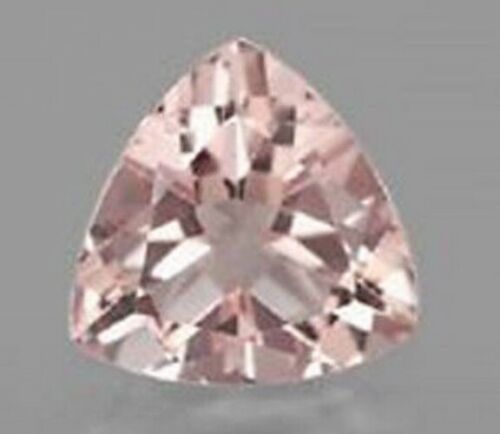-40%
7.83 cts Natural Oval-cut Dazzling-luster AAA Pink VS Morganite (Brazil)
$ 660.26
- Description
- Size Guide
Description
7.83 cts Natural Oval-cut Dazzling-luster AAA Pink VS Morganite (Brazil)New without Tags. This gem has never been used/placed/set in a setting.
It is utterly undamaged, unmarred and in perfect condition as expected of NWOTags.
I have included a Morganite article below for your appreciation and enjoyment.
Summary of below: "
Morganite
is the light pink to violet-pink variety of
beryl
." ... "
Among the beryls, morganite is one of the rarest forms, second only to red bixbite." ... "Morganite is usually quite clean, unlike emerald which tends to be heavily included." ... "A pure pink morganite is considered most desirable but more recently, peachy and salmon colored stones have been in very high demand." ... "Morganite occurs with excellent transparency. Unlike emerald, it rarely forms with inclusions, thus, eye-clean stones are expected. Morganite exhibits an attractive vitreous luster when cut and polished." ... "Morganite is often found unheated and unenhanced."
Type: Natural Morganite (aka Pink Emerald)
(personally confirmed as Genuine Morganite by digital refractometer (RI=1.578), dichroscope (minor birefringence as expected), polariscope (two flash cycles per rotation; not glass), spectroscope, UV short&long-wave specimen light, measured Specific Gravity=2.74) -- captej2012
Shape: Perfect Oval-cut
Weight: 7.83 cts
Dimensions: 15.00mm x 11.20mm x 7.30mm
Color: Pink
Luster: Superior
(the fantastic flashing luster of this particular gem could not be captured by the still-photography) -- captej2012
Hardness: 7.5~8.0 rating on the Mohs Scale
Clarity: VS
(exceptional color/clarity/luster/cut in a second-most-rare Beryl-family gemstone) -- captej2012
Treatment: Not Heated, Not Enhanced, Not Treated
Origin: Brazil
Michel Morgan, wandering
Spirit-of-the-Pink-Gem,
Defy the Tiresome Adventure of Never Knowing Next.
Those ever-changing Partners each night,
Content no longer the Thirst to be Quenched.
Be More by Being for Others not Yourself.
Use Your Learned Wariness to Protect & Promote.
For Progeny of Your Own,
Choose a Darling and Settle
Down.
We are an eBay eStore enterprise focused on selling mostly Loose Natural Gemstones. Stay here, look around and learn. Via eBay Messaging, ask us questions, make an offer, and otherwise discuss your wishes, concerns and hopes. We pride ourselves as good-spirited folks having fun and doing our best to share the joy of Nature's most beautiful and enduring literal treasure -- Natural Gemstones. Expect to find us cheerful and trustworthy, and we will expect the same of you. For us, Negative FeedBack as a means of coercion is never needed and only degrades everyone's enjoyment in what should otherwise be a fun shopping experience. And finally, please enjoy my work as eBay's First (unofficial) Gemstone Poet. -- captej2012
========================================================================
Morganite Gemstone Information
About Morganite - History and Introduction
Morganite
is the light pink to violet-pink variety of
beryl
. Since beryl is most famous for being the mineral group that green emerald belongs to, pink morganite is sometimes referred to as 'pink emerald'. Along with emerald, morganite is also related to blue aquamarine, golden beryl (heliodor), colorless goshenite and the
rare red bixbite
. Among the beryls, morganite is one of the rarest forms, second only to red bixbite.
Pink morganite
was first identified in California, USA, in 1910 by
George D. Kunz
, a famous American gemologist and buyer for Tiffany & Company. At first, it was simply referred to as 'pink beryl', but the year following its discovery, it was renamed by George Kunz in honor of
John Pierpont (J.P.) Morgan
, an American banker and avid gemstone collector. Since its discovery, morganite has been prized by gem collectors owing to its rarity.
Morganite
Identifying Morganite
Morganite is an aluminum beryllium silicate. Its color can range from pale pink to violet, salmon or peach. Along with other beryls, morganite has very good hardness, with a rating of 7.5 to 8 on the Mohs scale. The refractive index is 1.562 to 1.602. Beryl generally has a specific gravity of 2.66 to 2.87, but morganite is slightly denser than other beryls at 2.71 to 2.90. Morganite is usually quite clean, unlike emerald which tends to be heavily included. In most cases, morganite can be easily distinguished from other pink stones by its brilliance and luster, combined with its hardness, durability and excellent clarity.
Morganite; Origin and Sources
Morganite can be found in many locations around the world. The two most significant deposits are found in Brazil and Madagascar. Other notable sources for fine gem-quality morganite include Afghanistan, China, Madagascar, Mozambique, Namibia, Russia, Zimbabwe and the USA (California and Maine).
Buying Morganite and Determining Morganite Value
Morganite Color
Morganite ranges in color from pale pink to pink, violet-pink, peach, peachy-pink, or salmon color. Its color is thought to be owed to traces of manganese or cesium. Morganite is rarely vivid or intense in color; most stones are very pale or pastel colored. Large stones will typically exhibit stronger colors. A pure pink morganite is considered most desirable but more recently, peachy and salmon colored stones have been in very high demand. There is also a rare magenta colored morganite from Madagascar that is highly sought after by collectors.
Morganite Clarity and Luster
Morganite occurs with excellent transparency. Unlike emerald, it rarely forms with inclusions, thus, eye-clean stones are expected. Morganite exhibits an attractive vitreous luster when cut and polished.
Morganite Cut and Shape
Morganite is typically faceted to maximize its color and brilliance. With its indistinct cleavage, cutters must orient the stone properly to minimize cleavage. Rare materials which exhibit chatoyancy (cat's eye effect) are often cut en cabochon in order to best exhibit desirable effects. Morganite is most often cut into rounds ovals, cushions and pears, as well as trillions, hearts and briolettes.
Morganite Treatment
Morganite is often found unheated and unenhanced. However, many stones today may be routinely heat treated to improve color and remove unwanted yellow tones. Heating is done at relatively low temperatures (about 400 degrees centigrade) to achieve this effect.












